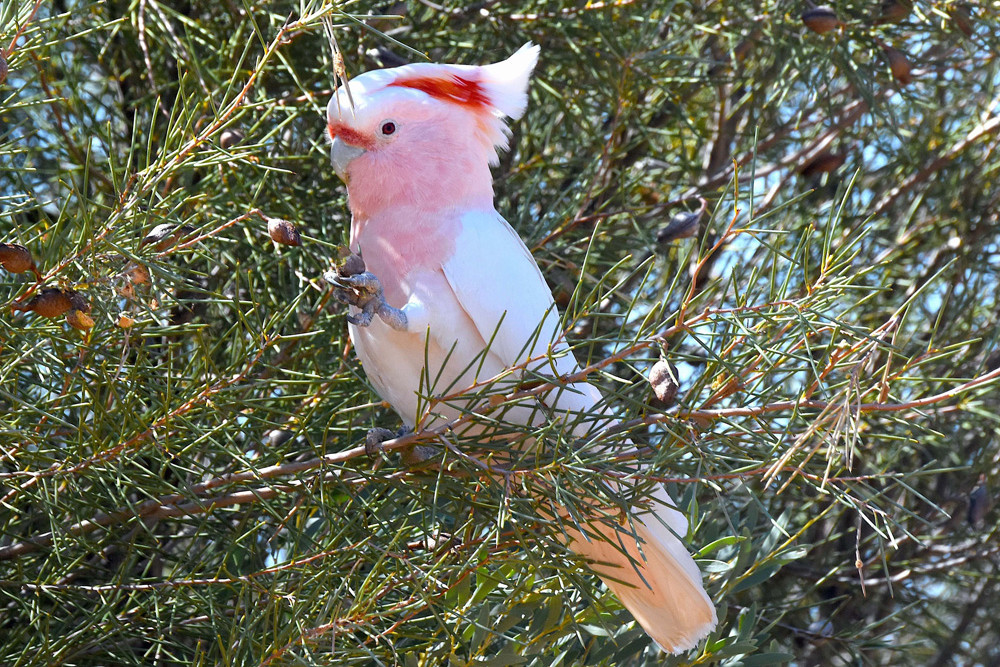Community & Business
31 May, 2023
Pink cockatoo now endangered
AUSTRALIA is often called the land of parrots, with good reason, and that is especially so if we consider the cockatoos.

Of the twenty one species, 14 occur only in Australia and the remainder on nearby islands of Indonesia and New Guinea.
One of the most colourful of these is the Pink Cockatoo, a distinctive highly noticeable species that is sparsely distributed across arid and semiarid Australia, occurring in each mainland state.
The pink plumage stands out, especially the bright underwings as they fly, but also the erectile crest that is used to communicate.
Concern has been expressed about the declining population and in a recent announcement by the Australian Environment Minister, the threatened status of the Pink Cockatoo is now considered endangered, reflecting the severe decline in reporting over recent decades – a drop of some 70 per cent.
The focus of concern is the eastern subspecies that occurs in small parts of inland Queensland, South Australia, Victoria and New South Wales.
There is no doubt this is a much loved bird and it is always remarked upon when seen due to its gorgeous beauty and flamboyant crest.
Like most Australian threatend species, the population declines are a result of habitat loss, but in the case of this species (and some others) there is a critical loss of breeding hollows.
This situation is a little complex due to compounding fac-tors.
First, for a tree to develop hollows it must live a long time (few have hollows before they reach 80-100 years old).
Then an appropriate event must occur to facilitate the crea-tion of a hollow, often fire or dis-ease related.
Eventually the hollows become suitable for nest sites and are much valued by many spe-cies.
Competition for the surviving hollows has increased, including from introduced species such as feral bees.
But in modern Australia, an additional challenge is the failed recruitment of new replacement
trees of suitable age.
This is because of destructive land use practices that halt regeneration of the trees, such as grazing animals, introduced pests and inappropriate fire regimes.
Pink Cockatoos occur mainly in open woodlands of arid or semi-arid environments, especially with mulga and other wattle shrubs, mallee, cypress pine and casuarina.
They feed on seeds of trees and shrubs, sometimes eat insect larvae and in places have been seen eating fruit and seeds from introduced weed species.
Always sparse and usually seen in small parties pf two or three, the Pink Cockatoo is now even more scarcely seen.
What can be done? If this is not to be yet another example of recognizing the demise of a species without doing anything about it, as seems to be the case for many, a Recovery Plan needs to be developed and then funded.
With so many state governments and the national government involved it sounds like it should be easy.
Sadly, very few new Recovery Plans are being made and much less action is occurring in the face of the major increases in threats.
Habitat management is a really big issue as most of the habitat is outside protected areas on private lands, usually used for sheep and cattle grazing.
Locally it is possible to create artificial nest hollows that may be suitable for these magnificent cockatoos but the land manage-ment practices need to be adapted to support natural processes that sometimes take many centuries, well beyond the interest of most private organisations.
Indigenous Protected Areas offer a likely long term solution, as do not-for-profit conservation groups like Bush Heritage and the Australian Wildlife Conservancy.
Dedicated National Parks can also assist but today these are poorly funded and lack ap-propriate staff.
While adding the Pink Cockatoo to the list of Endangered Species is a first step of recognition, more importantly it will take action not words to save the species and for that we await a well-funded recovery plan


